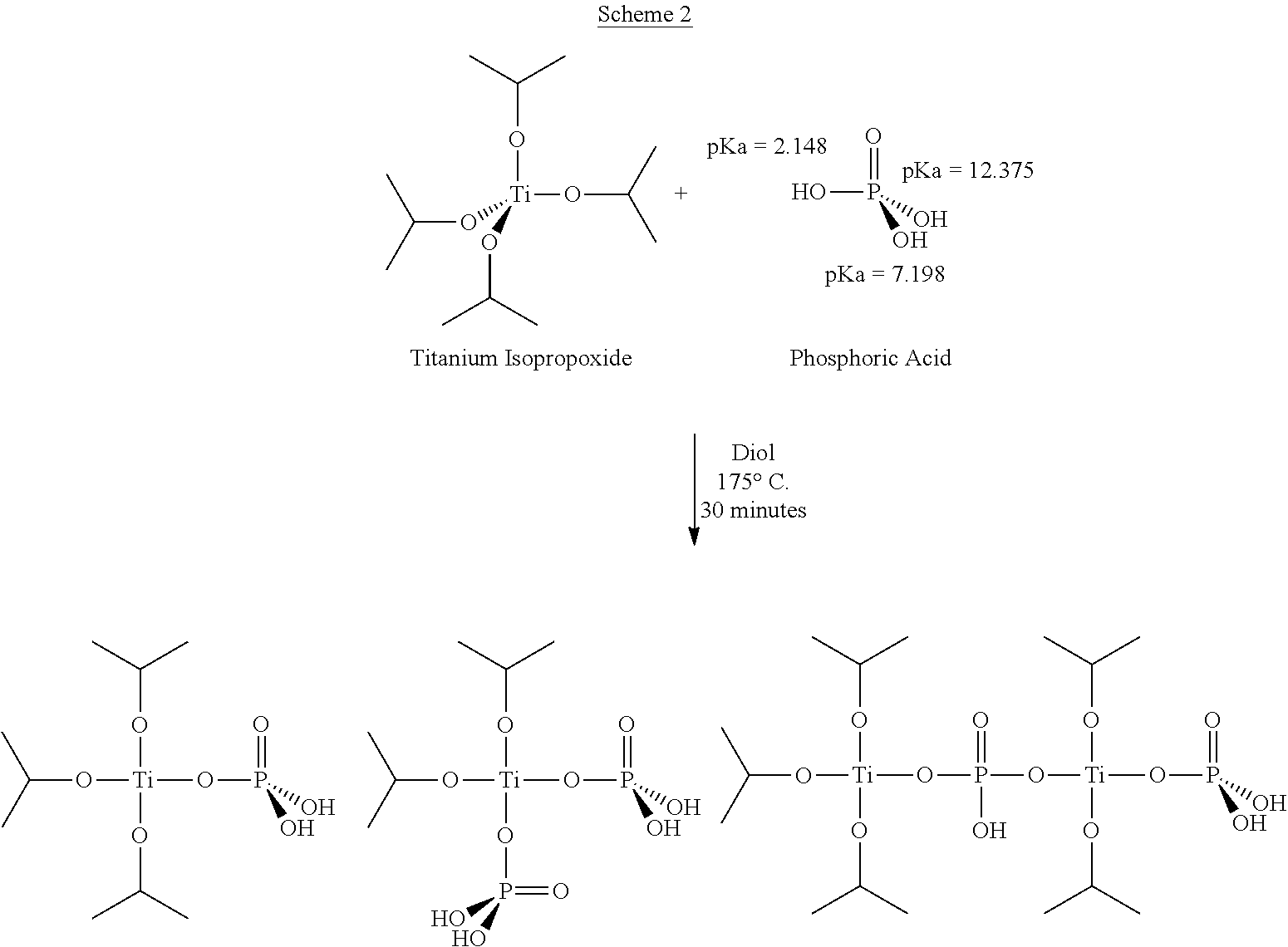Process for the Preparation of Modified Poly(Alkylene Terephthalate) Employing an In-Situ Titanium-Containing Catalyst
a technology of titanium-containing catalyst and modified polyalkylene terephthalate, which is applied in the field of process for the preparation of modified polyalkylene terephthalate using titanium-containing catalyst, can solve the problems of undesirable reactions, catalysts that have not been used in the production of modified polyalkylene terephthalates from pet, and can not be recycled sources of pbt generally, so as to improve the hydrolytic stability of the resulting modified polyalkylene ter
- Summary
- Abstract
- Description
- Claims
- Application Information
AI Technical Summary
Benefits of technology
Problems solved by technology
Method used
Image
Examples
example 2 (
E-2)
[0133]Modified PBT was prepared on a lab scale from recycled PET and 1,4-butandiol (BDO) in the presence of a phosphorous-containing catalyst prepared in situ through the complexation between TPT and phosphoric acid in a 1:0.3 molar ratio. First, 50 g of BDO and 0.15 ml of phosphoric acid solution in water (0.1 g / ml) were introduced into a three neck round bottom flask. The reactor was placed in an oil bath at a temperature of 175° C. After 20 minutes, 250 ppm of TPT was added to the reactor and an in situ complexation between phosphoric acid and TPT was carried out for 40 minutes under N2 atmosphere. Then, 87.4 g of PET and 80 g of additional BDO were introduced into the catalyst solution, and the ester interchange temperature was increased to 220° C. at a rate of 2° C. / min while stirring at 260 rpm under nitrogen. After the depolymerization ceased, the temperature of the reaction mixture was further increased to 250° C. to melt the residual PET flakes completely. Polymerizatio...
example 3 (
E-3)
[0134]Modified PBT was prepared on a lab scale from recycled PET and 1,4-butandiol (BDO) using a catalyst was prepared in situ by the reaction between TPT and phosphoric acid in a 1:0.6 molar ratio. First, 50 g of BDO and the phosphoric acid solution (0.1 g / ml in water), to provide the necessary ratio, were introduced into a three neck round bottom flask. The reactor was placed in an oil bath at a temperature of 175° C. After 20 minutes, 250 ppm of TPT was added to the reactor, and an in situ complexation between phosphoric acid and TPT was carried out for 40 minutes under a N2 atmosphere. Then, 87.4 g of PET and 80 g of additional BDO were introduced into the catalyst solution, and the ester interchange temperature was increased to 220° C. at a rate of 2° C. / min while stirring at 260 rpm under nitrogen. After the depolymerization is completed and ceases, the temperature of the reaction mixture was further increased to 250° C. to melt the residual PET flakes completely. Polymeri...
example 4 (
E-4)
[0135]Modified PBT was prepared one lab scale from recycled PET, and 1,4-butandiol (BDO) using catalyst that was prepared in situ by the reaction between TPT and phosphoric acid in 1:1 molar ratio. First, 50 g of BDO, phosphoric acid solution (0.1 g / ml in water), to obtain the indicated molar ratio, were introduced into a three-neck round bottom flask, which was placed in an oil bath at a temperature of 175° C. After 20 minutes, 250 ppm of TPT was added to the reactor and in situ complexation between phosphoric acid and TPT was carried out for 40 minutes under a nitrogen atmosphere. Then, 87.4 g of PET, and 80 g of additional BDO were introduced into the catalyst solution, and the ester interchange temperature was increased to 220° C. at a rate of 2° C. / min while stirring at 260 rpm under nitrogen. After the completed depolymerization ceases, the temperature of the reaction mixture was further increased to 250° C. to melt the residual PET flakes completely. Polymerization was in...
PUM
| Property | Measurement | Unit |
|---|---|---|
| temperature | aaaaa | aaaaa |
| pressure | aaaaa | aaaaa |
| temperature | aaaaa | aaaaa |
Abstract
Description
Claims
Application Information
 Login to View More
Login to View More - R&D
- Intellectual Property
- Life Sciences
- Materials
- Tech Scout
- Unparalleled Data Quality
- Higher Quality Content
- 60% Fewer Hallucinations
Browse by: Latest US Patents, China's latest patents, Technical Efficacy Thesaurus, Application Domain, Technology Topic, Popular Technical Reports.
© 2025 PatSnap. All rights reserved.Legal|Privacy policy|Modern Slavery Act Transparency Statement|Sitemap|About US| Contact US: help@patsnap.com


